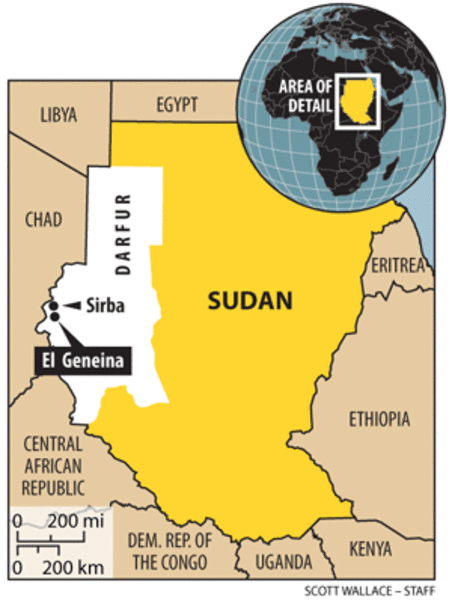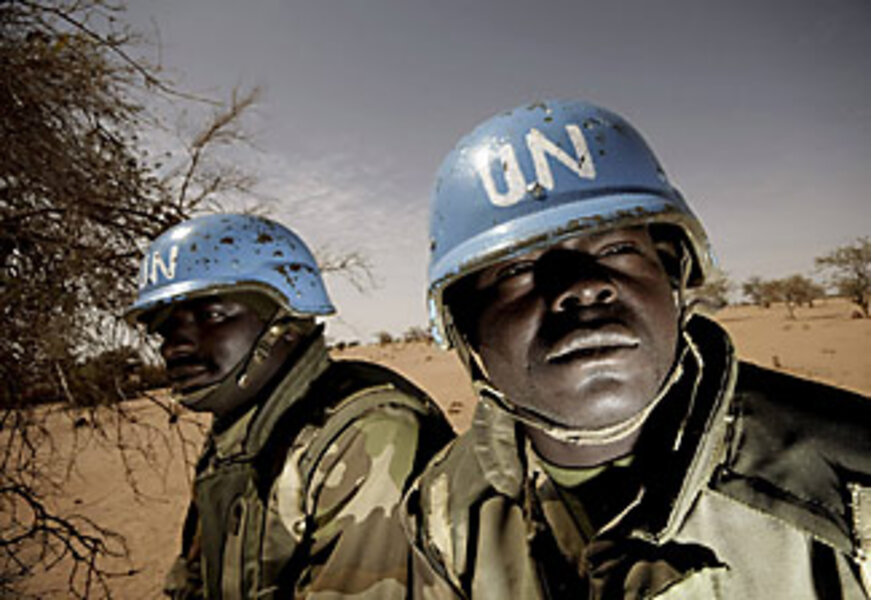U.N. force makes progress in Darfur
Loading...
| El Geneina, Sudan
Despite multiple peace efforts, the crisis in Sudan's western region of Darfur often appears only to deepen as time goes on.
On a recent day, for example, armed men ransacked shelter after shelter, says Sheikh Abdulrahman Hassan Yussuf, a tribal leader trying to protect his people in a camp for displaced people just outside the capital of west Darfur, El Geneina.
"They were looking for women," he says, standing in the moonlight outside a deserted food distribution center. "There were more than 20 of them – janjaweed," he says, referring to the feared government-backed Arab militias.
But now security is beginning to improve.
Lieutenant Adeyinka Adeyemo, of the United Nations-African Union Mission in Darfur (UNAMID), turns to his translator and asks him to relay a message to the sheikh. "Ask him how we can catch these people. Tell him I will come to catch them. All he has to do is phone me," says the Nigerian officer.
Behind him an armored personnel carrier disappears into the narrow sandy tracks that criss-cross the camp.
This was once a no-go area for the beleaguered, 7,000-strong African Union (AU) force charged with trying to bring peace to Darfur. Outgunned by rebels and powerless to take on government-allied militias, they had become increasingly confined to their bases.
But on January 1 they changed their green helmets for UN blue and resumed night patrols as part of a hybrid force comprising both the UN and AU.
Sheikh Abdulrahman says the presence of international peacekeepers has already helped security.
"If they see the patrols then they will not be back," he says of the Arab raiders who treat the camps as supply depots. "But if they don't see them for a while then they will come back."
And there is the problem.
Eventually the hybrid force will comprise 26,000 uniformed soldiers and police officers.
But no one knows when the force will reach full strength. Troop contributing countries are struggling to meet their commitments and the Sudanese government has spent the past five years perfecting the art of obfuscation.
Current strength is just over 9,000 personnel, barely more than the African force that struggled to impose itself on a region the size of France.
The result, according to some analysts, is precious little progress on the ground so far.
Alun McDonald, a spokesman for the England-based charity Oxfam, says security is no better for the average Darfuri than it was before January.
"They have made some small differences in the areas where they have deployed in terms of restarting patrols, engaging with community leaders," he says.
"But bombings and fighting between rebels and government continue just as they always have done."
Nowhere is the bombing and fighting more obvious than on the road out of El Geneina known as the Northern Corridor.
Village after village bears the scars of war. Simple thatch huts are replaced by blackened ashes. Broken pottery litters marketplaces as a UNAMID patrol passes, following the dust road to Sirba and Sileia.
This strategic region along the border with Chad was taken by rebels of the Justice and Equality Movement in December. The government took it back in February, sending Antonov bombers and the janjaweed to do its dirty work.
A report by UNAMID puts the death toll at 115. Another 30,000 people were forced from their homes.
Tribal elders in Sileia echo their counterparts in El Geneina as two white armored personnel carriers park in the shade of an acacia tree.
"Now the UN cars are here, stopped in front of us, so we feel safe, says Adam Omar Mohammed as he sits on a piece of cardboard in the town square. "We want the UN to come here and stay here."
He may get his wish. UNAMID commanders are planning to build a small observation post in the town.
But for now they are powerless to stop full-scale military engagements.
After the February attacks, it took days for monitors to arrive from El Geneina where they had been besieged by aid workers demanding they intervene.
"We feel disappointed," said Colonel Amgad Morsy, chief of staff for UNAMID Sector West. "We don't have the capability. It's a weekly and daily dispute that IDPs [internally displaced people] come and say: 'Our people are being harassed, our women are raped.' What we can do is try to build confidence, but it's still the very minimum."
He points to the resumption of night patrols and escorts for women collecting firewood, but says for now his No. 1 priority has to be ensuring that his soldiers are safe.
There is no doubt that it will take time for his force to reach the levels it needs to provide real security. But there are other questions about the environment they will find themselves trying to police.
Professor Elteyb Hag Ateya, director of the Peace Research Institute at Khartoum University, says the African Union mission failed because of the absence of a stable cease-fire or peace deal, not necessarily because the lack of troops, helicopters, or cash.
The new hybrid force, he adds, has inherited the same conditions and conundrum.
"African forces were brought into an incomprehensible situation," says Mr. Ateya. "No one knew who were the good guys and who were the bad guys.
"What is UNAMID to do?" he says. "Keep peace? With whom and between whom? That is the question."






